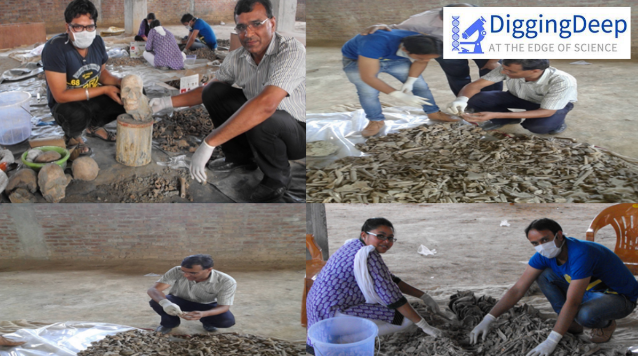
Copyright infringement is not intended
Context: New genetic proof links 246 Indian soldiers killed in Punjab’s Ajnala during 1857 uprising to Gangetic plains.
Key findings:
- The new evidence has put a lid on all hypotheses and folklore swirling around the Sepoy Mutiny in this Punjab district.
- Archaeologists have called the site the largest possessing skeletal remains linked to any single event during the 1857 Indian rebellion.
About 1857 rebellion:
- Revolt of 1857 was first started on May 10, 1857, by sepoy mutiny in Meerut.
- The revolt lasted for a year but was unsuccessful. A major highlight of this revolt was that it abolished the East India company’s rule in India.
- Central and northern parts of India took part in the revolt of 1857 and there were various reasons that bundled up the Indians.
- It is known as the Sepoy Mutiny or the Sepoy Rebellion because the Revolt of 1857 first started in the hearts of our (sepoys) soldiers who faced discrimination and racism by the British generals.
Timeline of the Revolt of 1857
|
Important dates
|
Events
|
|
February 1857
|
Sepoys of the 19th Native Infantry refused to use rifles.
|
|
March 1857
|
The Native Infantry disbanded after Mangal Pandey injures 2 British soldiers.
|
|
April 1857
|
Mangal Pandey is hanged and troops at Meerut refused to use greased cartridges.
|
|
May 1857
|
Unrest in Ambala, troops slaughter Europeans and Christians as they reach Delhi. Bahadur Shah II was proclaimed as the Mughal ruler in Delhi. Jhansi state was captured by rebels and handed over to Rani of Jhansi.
|
|
June 1857
|
Mutinies in Lucknow, Bhurtpore and Rohilkhand started.
|
|
July 1857
|
Unrest in the entire country. Nana Sahib was defeated in the first battle of Cawnpore. Lord Canning issued his ‘Clemency’ resolution stating that mutineers who aren’t convicted of murder should not be hanged.
|
|
September 1857
|
Delhi captured and cleaned of rebel groups.
|
|
November 1857
|
Kavanaugh escaped from Lucknow. Children and Women evacuated from Lucknow. British withdraw from Lucknow.
|
|
December 1857
|
Tantia Tope was defeated in the third battle of Cawnpore.
|
|
April 1858
|
Jhansi was captured by the British.
|
|
June 1858
|
Battle of Gwalior and Rani of Jhansi’s death.
|
|
August 1858
|
Queen Victoria transferred the authority of India from the East India Company to the Crown.
|
|
April 1859
|
Tantia Tope was executed after being found guilty of betrayal.
|
|
July 1859
|
Peace declared.
|
Revolt of 1857 Causes and Effects
The main cause of the Revolt of 1857 was the end of company rule and the establishment of direct rule by the British government in India.
The 4 major causes of the sepoy mutiny in 1857 were based on political, economic, military & social causes. Here are all the details.
- Political Causes –In the late 1840s, Lord Dalhousie imposed the Doctrine of Lapse. Under this, no ruler was allowed to adopt any child & only the natural heir has the right to rule. The political cause was the extension of British policies like the Doctrine of Lapse. The state would be annexed if the ruler dies without any male heir and was under the East India Company.
- Economic Causes –The peasants & farmers were affected by the various British reforms and were forced to pay heavy taxes. So, the ones that were unable to pay the taxes or loans had to surrender their lands to the Britishers. Constantly Indians have to compete with the British industry machine manufactured goods with Indian handicraft goods.
- Military causes – The Indian sepoys were paid less than European sepoys. Indians were considered menial & European sepoys were given much importance in terms of salary, pension & promotion.
- Social Causes – East India company abolished Sati pratha, child marriage & encouraged widow remarriage, at that time it was considered as a threat to Indian traditions. Britishers wanted Hindus & the Muslim religion to be converted into Christianity.
What Were the Effects of the Revolt of 1857 on India?
- The revolt of 1857 was not a success but created a huge impact on India.
- The major impact was the abolishment of the East India Company, India was under the direct control of British authority, the Indian administration was directly controlled by queen Victoria.
- The second impact that the revolt of 1857 created was to develop unity & patriotism among the nation.
- Press was restricted since the Revolt of 1857 involved the Peasants as well. The press played an important role in the freedom struggle. It helped to educate Indians, influence them & aware of government policies.
Centers of the Revolt of 1857
The revolt spread over the entire area from the neighbourhood of Patna to the borders of Rajasthan. The main centres of revolt, commonly known as the sepoy mutiny in these regions namely Kanpur, Lucknow, Bareilly, Jhansi, Gwalior, and Arrah in Bihar.
- Lucknow– It was the capital of Awadh. Begum Hazrat Mahal, one of the begums of the ex-king of Awadh, took up the leadership of the revolt.
- Kanpur– The revolt was led by Nana Saheb, the adopted son of Peshwa Baji Rao II.
- Jhansi– The twenty-year-old Rani Lakshmi Bai led the rebels when the British refused to accept the claim of her adopted son to the throne of Jhansi.
- Bihar – The revolt was led by Kunwar Singh who belonged to the royal house of Jagdispur, Bihar.
https://indianexpress.com/article/india/genetic-proof-indian-soldiers-punjab-ajnala-gangetic-plains-7891150/#:~:text=Latest%20DNA%2Dbased%20evidence%20confirm,the%20Gangetic%20plains%2C%20researchers%20said




